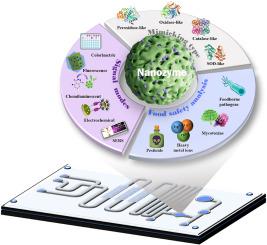当前位置:
X-MOL 学术
›
Trends Food Sci. Tech.
›
论文详情
Our official English website, www.x-mol.net, welcomes your feedback! (Note: you will need to create a separate account there.)
Nanozyme-enabled microfluidic biosensors: A promising tool for on-site food safety analysis
Trends in Food Science & Technology ( IF 15.3 ) Pub Date : 2024-04-10 , DOI: 10.1016/j.tifs.2024.104486 Xiru Zhang , Danqing Zhu , Xinyan Yang , Chaoxin Man , Yujun Jiang , Qianyu Zhao , Xianlong Zhang
Trends in Food Science & Technology ( IF 15.3 ) Pub Date : 2024-04-10 , DOI: 10.1016/j.tifs.2024.104486 Xiru Zhang , Danqing Zhu , Xinyan Yang , Chaoxin Man , Yujun Jiang , Qianyu Zhao , Xianlong Zhang

|
Food safety as a critical topic of international concern has obtained increasing attention worldwide. Thus, it is of great significance to develop sensitive, accurate, and rapid detection methods for food safety analysis. In recent years, emerging nanozymes have become a promising alternative to natural enzymes for the development of biosensors to achieve food safety analysis due to their simpler preparation processes, more robust activity, higher stability, higher recycling efficiency, and lower cost compared with that of natural enzymes. To achieve portable and on-site detection, nanozyme-based biosensors have been successfully integrated with advanced microfluidic devices (e.g., microfluidic chips) for the construction of nanozyme-enabled microfluidic biosensors to realize the rapid detection of food contaminants. In this review, we summarized the latest advances on nanozyme-enabled microfluidic biosensors and their applications in the field of food safety analysis. Firstly, a comprehensive summary and discussion on the catalytic mechanisms and roles of nanozymes for the construction of biosensors were conducted. Then, attention was focused on the nanozyme-enabled microfluidic biosensors and their applications in the field of food safety analysis, including the detection of foodborne pathogens, mycotoxins, heavy metal ions, and pesticide residues. Impressively, the remaining challenges and chances in this significant and promising field were proposed. Emerging nanozymes have been successfully combined with microfluidic technology, opening a new avenue for rapid, sensitive, and on-site food safety analysis.
中文翻译:

纳米酶微流体生物传感器:一种有前景的现场食品安全分析工具
食品安全作为国际社会关注的重要话题,越来越受到世界各国的关注。因此,开发灵敏、准确、快速的检测方法对食品安全分析具有重要意义。近年来,新兴的纳米酶由于与天然酶相比具有更简单的制备工艺、更强的活性、更高的稳定性、更高的回收效率和更低的成本,已成为天然酶的有前途的替代品,用于开发生物传感器以实现食品安全分析。酶。为了实现便携式和现场检测,基于纳米酶的生物传感器已成功与先进的微流控器件(例如微流控芯片)集成,构建纳米酶驱动的微流控生物传感器,以实现食品污染物的快速检测。在这篇综述中,我们总结了纳米酶微流控生物传感器的最新进展及其在食品安全分析领域的应用。首先对纳米酶构建生物传感器的催化机制和作用进行了全面的总结和讨论。然后,人们的注意力集中在纳米酶微流控生物传感器及其在食品安全分析领域的应用,包括食源性病原体、霉菌毒素、重金属离子和农药残留的检测。令人印象深刻的是,提出了这个重要且有前途的领域中剩余的挑战和机遇。新兴的纳米酶已成功与微流控技术相结合,为快速、灵敏、现场食品安全分析开辟了新途径。
更新日期:2024-04-10
中文翻译:

纳米酶微流体生物传感器:一种有前景的现场食品安全分析工具
食品安全作为国际社会关注的重要话题,越来越受到世界各国的关注。因此,开发灵敏、准确、快速的检测方法对食品安全分析具有重要意义。近年来,新兴的纳米酶由于与天然酶相比具有更简单的制备工艺、更强的活性、更高的稳定性、更高的回收效率和更低的成本,已成为天然酶的有前途的替代品,用于开发生物传感器以实现食品安全分析。酶。为了实现便携式和现场检测,基于纳米酶的生物传感器已成功与先进的微流控器件(例如微流控芯片)集成,构建纳米酶驱动的微流控生物传感器,以实现食品污染物的快速检测。在这篇综述中,我们总结了纳米酶微流控生物传感器的最新进展及其在食品安全分析领域的应用。首先对纳米酶构建生物传感器的催化机制和作用进行了全面的总结和讨论。然后,人们的注意力集中在纳米酶微流控生物传感器及其在食品安全分析领域的应用,包括食源性病原体、霉菌毒素、重金属离子和农药残留的检测。令人印象深刻的是,提出了这个重要且有前途的领域中剩余的挑战和机遇。新兴的纳米酶已成功与微流控技术相结合,为快速、灵敏、现场食品安全分析开辟了新途径。






























 京公网安备 11010802027423号
京公网安备 11010802027423号